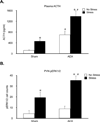Tonic, but not phasic corticosterone, constrains stress activatedextracellular-regulated-kinase 1/ 2 immunoreactivity within the hypothalamic paraventricular nucleus
- PMID: 21929693
- PMCID: PMC3220802
- DOI: 10.1111/j.1365-2826.2011.02220.x
Tonic, but not phasic corticosterone, constrains stress activatedextracellular-regulated-kinase 1/ 2 immunoreactivity within the hypothalamic paraventricular nucleus
Abstract
The negative-feedback actions of corticosterone (CORT) depend on both phasic and tonic CORT secretion patterns to regulate hypothalamic-pituitary-adrenal (HPA) axis activity. How these two different CORT secretion pattens influence specific intracellular signal transduction pathway activity within the cellular elements of the HPA axis has not been determined. For example, it is unknown whether CORT has suppressive actions over signal transduction events within medial parvocellular paraventricular nucleus (PVN) corticotrophin-releasing hormone (CRH) neurones, nor whether these suppressive actions are responsible for alterations in PVN transcriptional processes and neurohormone secretion associated with stress. The extracellular-regulated kinase (ERK) is a stress activated intracellular signalling molecule that is potentially subject to glucocorticoid negative-feedback regulation. We tested the ability of CORT to modulate levels of the active (phosphorylated) form of ERK (pERK1/2) in the PVN of rats. Acute psychological stress (restraint) produced a rapid increase in the number of PVN pERK1/2 immunopositive cells within CRH neurones. Absence of tonic CORT via adrenalectomy (ADX) produced no change in basal pERK1/2 cell counts but augmented the increased pERK1/2 cell counts elicited by acute restraint. Treatment of ADX rats with CORT in the drinking water normalised this enhanced pERK1/2 response to stress. By contrast, treatment of ADX rats with a phasic increase in CORT 1 h before restraint had no effect on pERK1/2 cell counts, despite substantially suppressing stress-induced PVN crh gene expression and adrenonocorticotrophic hormone secretion. This tonic CORT inhibition of stress-induced activation of ERK1/2 may involve both alteration of the activity of stress-dependent neural inputs to PVN CRH neurones and alteration within those neurones of stress-dependent intracellular signalling mechanisms associated with ERK activation.
© 2011 The Authors. Journal of Neuroendocrinology © 2011 Blackwell Publishing Ltd.
Figures





References
-
- Keller-Wood ME, Dallman MF. Corticosteroid inhibition of ACTH secretion. Endocr Rev. 1984;5(1):1–24. - PubMed
-
- Dallman MF, Akana SF, Cascio CS, Darlington DN, Jacobson L, Levin N. Regulation of ACTH secretion: variations on a theme of B. Recent Prog Horm Res. 1987;43:113–173. - PubMed
-
- Sapolsky RM, Romero LM, Munck AU. How do glucocorticoids influence stress responses? Integrating permissive, suppressive, stimulatory, and preparative actions. Endocrine reviews. 2000;21(1):55–89. - PubMed
-
- Akana SF, Jacobson L, Cascio CS, Shinsako J, Dallman MF. Constant corticosterone replacement normalizes basal adrenocorticotropin (ACTH) but permits sustained ACTH hypersecretion after stress in adrenalectomized rats. Endocrinology. 1988;122(4):1337–1342. - PubMed
-
- Jacobson L, Akana SF, Cascio CS, Shinsako J, Dallman MF. Circadian variations in plasma corticosterone permit normal termination of adrenocorticotropin responses to stress. Endocrinology. 1988;122(4):1343–1348. - PubMed
Publication types
MeSH terms
Substances
Grants and funding
LinkOut - more resources
Full Text Sources
Medical
Miscellaneous

